Local Heroes
By David HandelmanTwo new acts, already successes in their home towns, attracted the attention of virtually every record company in America. Will Tommy Conwell and Jane’s Addiction end up superstars or casualties of the bidding wars?
Monday is usually the worst night of the week for a club, but on this particular Monday, January 26th, 1987, the Roxy, in Los Angeles, is packed. Glam rockers and slam dancers press the stage; toward the back sits a more sedate crowd – 150 representatives of the recording industry, including scouts from Atlantic, Columbia, Geffen, I.R.S., MCA, Slash and Warner Bros.
Onstage, after a few warm-up cartwheels to calm nerves, the local band Jane’s Addiction is delivering a woolly set. Lead singer Perry Farrell – scrawny and dreadlocked, wearing a nose ring and a psychedelic girdle – moves like a witch doctor, letting fly with his electronically processed, howling vocals. Guitarist David Navarro stands zombielike, casually booming out wild riffs from under a floppy hat; mop-top drummer Stephen Perkins smiles while pounding a tribal beat; and Eric Avery wrestles with his bass. Some songs are quietly beautiful, like “Jane Says” and “I Would For You.” Others are harsh, nearly spastic, like “Whores” (about a hooker friend of the band) and “Pigs in Zen,” during which Farrell sings, “Pig mounts sow / When he’s wound … I know about pain and suffering … And being cold … But I just wanna fuck.”
Some songs are not quite there yet, but the group has conjured up a convincing, unique sound; besides the drummer and guitarist are not yet twenty, and the band has been together less than a year, getting some demos aired on college radio, playing most gigs at wigged-out local underground clubs like Scream and the Pyramid Club.
Tonight the crowd is decidedly different, and Triple X, which manages Jane’s Addiction, has tried to be accommodating by reserving tables. Still, some label reps complain; one says, “I hope your preference in seating doesn’t reflect on your preference in picking a label.” At one point, Farrell yells out, “Fuck all you guys, we’re recording our own record!” (It’s no idle threat: the band has a mobile unit out back and will eventually release a record of the concert independently.) Afterward, Triple X’s Charley Brown tries to keep the backstage area off-limits, but one label representative somehow gets through.
“I hated it,” Farrell, 28, says later. “All of a sudden I’m to be judged by fuckers who don’t understand it to begin with. I felt like a zoo animal.”
Exactly one month later, on Thursday, February 26th, the labels cluster again, this time in the 23 East Cabaret, in Ardmore, Pennsylvania, seven miles outside Philadelphia. Onstage, blues-guitar wiz Tommy Conwell is leading the Young Rumblers through a polished set of hard, catchy pop. In the crowd of 450 are not only representatives from nearly every major label in America – including Polygram, Chrysalis and Capitol – but also the heads themselves of Atlantic (Ahmet Ertegun), RCA (Bob Buziak) and Arista (Clive Davis). The various labels acknowledge one another’s presence with outward nods and inward grimaces.
Conwell’s set includes the clever rocker “I’m Not Your Man,” the radio-friendly “Love’s on Fire” and other numbers the crowd already knows from the Rumbler’s independent album, Walkin’ on the Water. Recorded for $13,000, released in only the Philadelphia area just after Christmas and aided by heavy airplay from the top local rock station, WMMR, Walkin’ on the Water has sold an impressive 50,000 copies, a fact that helps explain the surprising presence of such heavies as Ertegun and Davis. “The act was pretested for you,” says Mike Bone, then at Elektra, now at Chrysalis, “and it worked.”
But the handsome, leather-jacketed Conwell, 24, who has been striving for success for more than three years, takes nothing for granted, working the room like a pro. Backed by the tight combo of Paul Slivka on bass, Jim Hannum on drums, Chris Day on guitar and Rob Miller on keyboards, he dances out across the tabletops, slapping out sweet licks, with sweat dripping off the end of his big, brown Guild guitar. “I believe in miracles,” he sings in his album’s title song, “and baby, you believe in me.”
Perhaps put off by the crunch of competition, Clive Davis leaves at intermission; the next day he has Conwell and his manager, Steve Mountain, to breakfast with him at New York’s Four Seasons; for the next night’s show, Elektra sends a bus containing its entire New York staff out to Ardmore. “The kid is inevitable,” says Arista’s Mitchell Cohen. “It’s like when you see a baseball pitcher in the minor leagues and you know he’s got all the moves.”
Backstage afterward, Conwell holds court, calm and courteous, remembering everyone’s name; Mountain makes sure the A&R people talk music, not money.
A&R stands for artists and repertoire. The label workers so named are initially talent scouts, going out on average three nights a week, seeing perhaps one signable band every few months. If a discovery is signed, the A&R person then becomes that act’s liaison to the label, consulting on recording and touring and motivating the labels promotion and marketing staffs to get out there and sell some product.
Most bands have to fight to kick up enough interest for one label to offer a deal, usually an unfavorable one. But a few times a year, a band gets a buzz about it, and the A&R people flock – sometimes out of true interest, often out of fear of missing out. That’s when the ante goes up.
It would be hard to find two acts as dissimilar as Tommy Conwell and Jane’s Addiction. The former plays feel-good commercial pop, honed by extensive East Coast gigging, and is supervised by a manager who has already brought one band, the Hooters, to platinum success. The later is dark, abrasive, less experienced but passionately committed to making a statement. Jane’s leader, Perry Farrell, is contentious and self-absorbed; he smokes pot and grows his own vegetables. His music-publishing company is named I’ll Hit You Back Music. Tommy Conwell is polite, has sword off drinking and drugs and works out regularly with the trainer of the Philadelphia Flyers and the 76ers. His publishing company is named Love Thing Music.
Yet both have worked diligently at their art and, through quirks of fate and taste, both were simultaneously in the same enviable situation, wooed by many of America’s major record labels. And both had to fight hard to keep their heads.
A typical major-label record deal works like this: The label sets the budget of a “recording fund” usually between $100,000 and $200,000, and sometimes gives the band an advance out of that – between $10,000 and $50,000 – to live off until other money starts coming in. The band uses the remainder of the fund to record the album and keeps whatever is left over, but the fund is “recoupable” – it is a loan to be repaid to the label with royalty income. The same holds true if the label offers tour-support money; the cost of videos is usually a split fifty-fifty with the label.
According to manager Danny Goldberg, whose clients include Belinda Carlisle, a superstars might command a twenty-percent royalty of a record’s retail price ($8.98), but new bands generally get ten to fourteen percent – roughly 67 to 95 cents per unit sold – with a higher rate if the album goes gold or platinum. Thus a band with a $100,000 recording fund may have to sell 200,00 copies to earn any additional money from royalties. (A label, on the other hand, earns an estimated $1 to $2 per record after expenses.) Surer income comes from writing your own material (and retaining the publishing rights): publishing pays songwriters roughly 3.75 cents per original song per album sold. So if a band writes ten tunes and sells 100,00 copies, that’s $37,500 in publishing income, which the band gets to keep, even if it owes money to the label. Few new bands are guaranteed more than one album – and even if they are, a label can bail out.
“No deal is as important as success,” says Goldberg. Even the biggest fund and advance dwindle in the face of taxes, management fees (ten to twenty-five percent), lawyers’ fees, the producer’s advance ($25,00 to $75,000) and equipment and studio costs. Everything is subject to change if your record begins to sell: the label will then likely put up as much additional money as is necessary and may renegotiate.
Thus, although a new band benefits from a sizable fund or advance, it shouldn’t be the deciding factor: in the end, it also means the biggest debt. Only an estimated fifteen percent of releases make a profit. And although the perks of courtship are nice, a band has to seek out a label that understands and is committed to it, that has a proven track record with marketing and selling new (perhaps similar) artists and that has a stable staff. Those characteristics can be hard to discern when people are waving all that money in your face.
Though record companies seemed to discover Tommy Conwell and Jane’s Addiction all of a sudden, neither act hatched overnight. After dropping out of college and having a nervous breakdown, New York-born Perry Farrell (not his real name) pounded L.A.’s streets for six years, trying to get something started, even living for two months with his girlfriend in a car.
By 1981, he had assumed his current name, a pun on peripheral, and organized a group called Psi-Com. After that fizzled, he sat in his room for two years with an amp, writing a rock opera called Buddy Clear-Eyes and bothering the neighbors. But Farrell had an idea;: a band that “didn’t fit,” that confronted issues like censorship and sexuality. The band’s lineup solidified in spring of 1986. At its first show, embarrassed by the group’s musical shortcomings, Farrell finally pulled down his pants onstage. But Jane’s Addiction improved with each outing, never playing the same show twice.
Farrell was managing the band himself, but he kept getting into fights with labor-abusive bar owners: the most the band ever made from a gig was $100. He was approached by Charley Brown, Dean Naleway and Peter Heur, who after working for a record distributor, had founded Triple X, a management company and record label that operates out of a noisy, cluttered office on Hollywood Boulevard. “So many bands are like ‘What image should I have? How can I write a hit?'” says Brown, 32. “I like outside bands. I tend to believe the most extreme stuff will eventually pull people along.” The band members liked the fact that Triple X was as hungry as they were, and they signed a record and management deal.
By Christmas, Slash had made a modest offer. “At the time, we were doing cartwheels,” says Brown. But Triple X had hired Owen Sloane, a high-powered, well-connected lawyer, who told Triple X it could do better than the Slash deal. Besides, a smaller label’s lower pay is normally compensated by its extra attention, and Triple X felt it could provide all the attention the band would need. The L.A. Weekly soon voted Jane’s the Best Underground Band and the Best Hard Rock/Metal Band. By then, the majors had already come calling.
Tommy Conwell dropped out of the University of Delaware in 1983, during his junior year, when he was earning more than he’d ever made – sixty dollars a night – playing in a blues band. (His brother Joe was doing even better playing professional football; today’s he’s a starting offensive tackle for the Philadelphia Eagles.) Then, after a brief stint as a guitarist in a pop band, Tommy decided to start how own group with two locals, Paul Slivka and Jim Hannum. The trio played its first concert on February 24th, 1984, leading off with Link Wray’s “Rumble.” Conwell booked the gigs and drove the van himself. Six months later, he hooked up with Steve Mountain, a former social worker who had started a management company called Cornerstone, was running three Philadelphia-area bars with partner Alan Berger and was managing the local band the Hooters, who had just released an independent LP.
“In the beginning, Tommy was like any other young local band,” says the bearded, intense Mountain, 31, sitting in his spacious, immaculate office above the 23 East Cabaret, in Ardmore. “He was wild, young, undisciplined, disorganized and cocky.”
So, Mountain says, he “beat the shit out of the band” to get it road worthy. He had the Rumblers play five or six nights a week for three months, booking them any place within a hundred-mile radius that he could wrangle a gig: high-schools, bars, colleges, race tracks. Down to Washington, out to the jersey Shore, over to western Pennsylvania. Everywhere except New York City; Mountain says, “You never really get the staging you want, you don’t get paid, you don’t get the audience you want. You get people coming out trying to prove you’re not as good as your hype.”
The Hooters had gone the same route and had sold an unheard-of 110,000 copies of their independent album, yet had been pursued by only two labels. When Columbia signed them, it got a well-seasoned road act – and a platinum album.
And when Conwell saw the Hooters play at the Amnesty International benefit on June 15th, 1986, he realized the big time was actually within his grasp. At the suggestion of the Hooters’ producer and A&R man, Rick Chertoff, he began going into New York every Tuesday for voice lessons; he also took performance lessons and worked with fitness trainer pat Croce, a friend and client of Mountain. Three days a week, Conwell is at Croce’s camp by 8:30 a.m., enduring a gut-wrenching workout similar to the one followed by Croce’s students Mike Schmidt and Julius Erving: weights, running, aerobics, treadmill, rowing machines.
Nowadays, the only drinks found backstage at a Rumblers show are fruit juice and Exceed, a fluid-hydration drink; before concerts, the band sometimes does jumping jacks. But Conwell takes the change in stride. “There was a time,” he says, “when drinking beer and chasing girls fit my life. If I was into work when I was eighteen, I’d probably be a jarhead like Mountain. I wouldn’t suggest working out to some kid dreaming of playing guitar, but there comes a point when it’s time to do it. It’s making me mentally tough – it tells me I can do anything.”
WMMR had played some Rumblers demos and got a good response; Mountain decided it was time to record an independent album. But after a disappointing gig opening for Robert Palmer at Philadelphia’s 15,000-seat Mann Music Center on July 3rd, 1986, the band decided to beef up its sound. So when the Rumblers entered the studio in December, they were augmented by guitarist Chris Day and keyboardist Rob Miller. By January, Walkin’ on the Water was in the stores, selling briskly, and was quickly noticed by the labels that had missed out on the Hooters.
Jane’s Addiction was looking for a label that could handle an offbeat band that might not get much radio play; Tommy Conwell was thinking bigger, seeking a label that could handle – to use Steve Mountain’s phrase – “tonnage.” Both bands visited the offices of as many labels as possible, meeting the staffs, viewing videos and hearing a wide range of pitches.
At one label, Jane’s like the A&R man, but when Charley Brown and Dean Naleway went to the offices, they saw workers yelling at each other. Then they were brought to the office of the label president, who “didn’t even look at us eye to eye,” says Naleway. Instead, he shot a minibasketball at a hoop and bragged about how much money the label had and how he’s just shelved seven new bands’ records. The whole time, the A&R man was scurrying around rebounding and returning the ball; when he made a joke about leaving the company, the president said, “That’ll be pretty hard to do with two broken arms and legs.” Brown shudders when he recalls the experience, saying, “They couldn’t offer us enough money to go there.”
Another A&R person attended some shows, talked to the band members a few times, then took them around the empty offices after hours, pointing out where the various staff members sat rather than actually introducing the band to any of them.
“A lot of labels were mainly into the fact that other labels were into the band,” says Brown. “I could see it in their eyes, and by the kinds of videos they showed us, that they didn’t understand what we were trying to do. We want a lot of people to like the band, but we don’t’ want to be a wimpy, MOR sellout band.”
Farrell says that all the A&R attention as “like meeting your mother-in-law. You’re nervous at first, but after a while, you don’t give a shit.” He scared off a few labels himself with his belligerence. He bragged to one label about having a great idea for a video, then refused to tell it because he though the label would steal it. Another label found Farrell too off-putting as a performer and thought him more poser than poet.
It eventually became apparent that Jane’s Addiction needed a label that not only truly grokked the band but also was nearby and accessible. Among the final contenders were Capitol, which had recently restaffed; Geffen, which has been known to meddle with bands (like Tesla or the highly touted Lone Justice); and Warner Bros., which has specialists in alternative promotion and marketing and a good reputation for signing difficult acts, like Hüsker Dü, Prince and the Replacements, and letting them develop.
“Up to the last minute, we weren’t sure,” says Brown. “Warners is apathetic; they don’t really peruse you; they say, ‘We’ll work with you if you want.’ And we were heavily chased by some other companies.”
In the end, the band members decided to go with Waners because of the staff’s stability (Robert Petersen, who signed them, has been there twelve years), strong distribution, understanding of the band and willingness to let it grow. “The last thing we want to do,” says Brown, “is hit the market with a big splash and jam the record down people’s throats. We want the band to earn it.”
The first three months of 1987, Steve Mountain and Tommy Conwell commuted from Ardmore to New York by train to meet labels on the label’s turf. They’d line up several companies per esxcursion and take meetings from 10:00 a.m. until 10:00 p.m., walking from one building to the next with only enough time between to grab a pretzel or a hot dog.
“Those meetings were tough,” says Mountain. “When you go to thirteen labels and you get thirteen pitches and they’re all saying the same thing, you have to ask that thirteenth label the same question you asked the first, even though you know the answer.” Some labels offer a free video; others said, “We’ll charge you for the vide but get you the right people to make it.” By the end Mountain found himself trying to stay fresh by alternating meetings between labels they liked and labels they didn’t – just for contrast.
Conwell says he saw the gamut of approaches: “Some of the guys greeted you in T-shirts, some in suits and ties. Some talked a lot about music, some about units moved. Some kissed your butt, some just hung out with you. Some companies are run by one person, others are more spread out. Musically, which is the bottom line, some of them make great rock & roll records, and some of them really don’t.”
Conwell’s participation in the meetings (like Farrell’s at his) was more instinctual than financial. “I didn’t ask about things like money or videos; management knows more about that. I wanted to figure out if they were going to let me make the record I wanted. You get a lot of yes answers. You have to judge by your knowledge of people. One company, the president’s eyes lit up when I began talking about jazz; he’d talk about seeing Charlie Parker play, lent me all these Louis Jordan records. And some guys sat there saying, “We’re talking points here and we got video and blah blah blah.”
Some labels only wanted to talk about the upside. But Mountain was concerned with what would happen if, God forbid, the first album stiffed. One company bragged about how one of its acts had been on MTV, done four videos, been worked and worked. Mountain learned that the album had sold only 28,000 copies. When he asked why, he was told, “But we made four videos, and he was on MTV and …”
Two labels wanted to re-release Conwell’s independent album; Mountain was against it, reasoning that the $13,000 record wouldn’t sound good alongside expensive major releases and that the five-piece band had greatly improved in the interim. He was disappointed that only three labels had any suggestions about how to make the band better: instead, he says, several wanted to “hold hands and ride off into the sunset” as millionaires.
PolyGram’s Jim Lewis, who went to see the Young Rumblers eight times, says the heavy A&R competition “became uncomfortable for Tommy. Who does he see first backstage? How long does he spend with them? He handled it well.” Warners’ Michael Hill says, “Mountain is the only manager I ever met who never stood next to me saying, “This is the song!'”
“It’s hard,” says Mountain. “We’re young, we’re in there with guys you read about in books: Clive Davis, Ahmet Ertegun, they’re some of the best schmoozers in the world. So we tried to be as low-key and respectful as we could – if anything, overcompensate.”
Mountain and the band also avoided the subject of money. “We talked philosophy,” Mountain says. “When do you make the record, how do you promote an act? This kid is a star, but only if it’s brought along correctly and he’s allowed to grow up.”
One lawyer advised Mountain to get a $200,000 commitment from Columbia and parlay that into perhaps $600,000 at, say, Manhattan, a new label needing a big act, or even $800,000 at MCA, a huge corporation known to spend big. “I thought, ‘What’s he counseling me to do?'” says Mountain, “If you sign an $800,000 deal, you’re signing a deal to fail.”
Yet the longer Mountain held out, the wider the offers became: blank checks or insinuating questions like “Steve, what do you want?” Mountain says, “That’s on the border of when a cop pulls you over and says he’s going to write you up, and you say, ‘Hey, need fifty bucks?'”
And although the industry line is that nobody gets bonuses, somebody in fact offered Mountain $250,000, unrecoupable. “I said, ‘That doesn’t mean anything to me,’ and it doesn’t. Because, ultimately, if you’re on the wrong label, you’re on the wrong label. And if somebody has to do that, they’re saying that’s the only way they can compete with the other guys.”
Like Jane’s, the Rumblers decided it would be best to work with a label on their own coast. Among the final contenders were Manhattan, a relatively new label; RCA, which had recently broken Bruce Hornsby; PolyGram, which had had success with Bon Jovi and John Cougar Mellencamp; and Columbia, which, with Warner Bros., is one of the two biggest labels.
Most labels assumed the band would sign to Columbia simply because Columbia had done well with the Hooters and Mountain knew the staff there; they felt he was playing the field just to raise the price. Mountain denies this. “We just wanted the belief in the band to go up, so that when the band signed, it would be really well connected at its label. It wasn’t the money – the way you make money is to sell records.”
Ultimately, Conwell did choose Columbia, but Mountain insists a musical decision: Conwell had become friendly with A&R man Rick Chertoff, a former musicians who had helped with Conwell’s songwriting and performance. Chertoff will produce the Rambler’s CBS debut, recording this November for release next spring. Conwell says, “I felt Columbia would let me take as long as it took and not be in my face the whole time. I wanted to work with them as much as possible. They’re not the big, bad record company to me.”
Mountain on Conwell made a few more trips to New York and visited each label to tell them their decision in person. Although the unusual gesture was appreciated, many of the labels still felt they had been led on: Mountain received one letter from a president warning him not to put all his acts on one label. Other labels began second-guessing themselves about Conwell: “I liked him,” says one A&R man, “but Im not haunted by his songs.”
“The minute you sign,” says Mountain, “it’s ‘Okay, see you later, gotta go sign another band.'”
Remember a band called the Unforgiven? Probably not. But the record industry does. This ironically named band came from San Bernardino County, California, wearing Clint Eastwood dusters, wielding four guitars and slinging hard Western rock. In the beginning of 1985, the Unforgiven shared a gig with Broken Homes, a band just signed to MCA, knowing MCA would be there. MCA was impressed and made an offer, and soon every gig was like an A&R convention.
The band eventually signed with Elektra for $225,000. Elektra promised two records, saying it didn’t matter if the first didn’t sell well. The Unforgiven’s debut album went through a few remixes and ran over budget. When the record came out, in August 1986, it sold about 50,000 copies. After the first single flopped, Elektra wouldn’t release a second, make a second video or pay any tour support, telling the band to say home and write new songs. Instead, the band took itself on the road, living hand-to-mouth for a year. Elektra recently dropped the band without the promised second album.
After the Unforgiven’s LP “stiffed,” the general assessment from rival labels was “I knew it all the time,” but many had vigorously pursued the band. Everyone has a theory in hindsight: maybe the band hadn’t hi its stride when it recorded; maybe the record wasn’t recorded right; or maybe the band was all hype, a gimmick that fooled the corporate machine. In any case, the Unforgiven, like other overhyped acts – John Eddie, Charlie Sexton, Sigue Sigue Sputnik – is a chilling reminder that all the attention lavished on a band doesn’t mean anything until a record is out, being worked – and succeeding.
Jane’s Addiction ended up with a recording fund rumored to be around $300,000 (even though at least one label offered twice that) and two guaranteed albums (with option for up to seven), but no tour support and, although the band had sought more, just one video. The price is high for a band not considered to be readily digestible.
“We have no illusions about being a big deal,” says Brown. “We just have someone who’ll pay to support our act so they can quit their day jobs. We still have a lot to prove.”
Tommy Conwell’s deal is looser, based on need; sources in the industry speculate that he could easily command a $500,000 commitment, but Mountain does not want to be that far in debt. “It’s an amazing deal,” says Mountain, “and most of it is at our discretion, assuming we’re being reasonable.” The deal guarantees two albums; both Columbia and Conwell have to come through for the contract to run beyond that. There are also firm video and tour-support commitments.
Yet Mountain does have the gnawing sense that “Columbia isn’t under this big pressure to deliver the act, whereas Manhattan would have had more to prove.”
“The hottest unsigned band, once signed, becomes the low man on the totem pole,” says Elektra’s Peter Philbin. “You have the new Cars album coming out, or Fleetwood Mac, or whatever.”
In the aftermath of the hyped-up signings, both band planned to lie low. But the Young Rumblers ended up playing numerous live gigs because offers had suddenly jumped from last year’s $1000-to-$2500 range to $3000 to $10,000. (Until recently, Jane’s had never made more than $1000; that’s been tripled.) The Rumblers finally pulled back in September so Conwell could work on his songwriting. Two songs from his indie album were collaborations with Robert Hazard; Mountain also wants to enlist Desmond Child and Jules Shear, who have written hits for Bon Jovi and Cyndi Lauper.
Jen’s didn’t take a sabbatical. The band turned down a big P.R. firm’s introductory offer to represent it free of charge for a trial period; it played only a few select gigs, opening for X in Irvine Meadows and the Psychedelic Furs in Santa Barbara. Jane’s also spent $7000 of its advance on a trip to New York for a frustrating appearance at the New Music Seminar. The band members spent some more recording a demo of “Oceanseize,” a song that mixes their acoustic and metallic edges, trying to persuade Warners to let them produce themselves. Warners had been pushing a commercial producer; when the label heard “Oceansize,” Brown says, the response was “smiles and grimaces: they don’t really know what to do with us yet. It’s pretty unsettling.”
“It’s starting to make me feel like it’s not fun anymore,” says Jane’s guitarist David Navarro. “I know that it’s work now, but they’re starting to have all this input, things that might not go with us creatively.”
“Why give somebody else the reins,” says Farrell, “when we’ve worked to get this sound? It’s like if you had a baby and somebody said, ‘I wanna raise your kid for you. I’ll give him back when I’m done.'”
“They don’t want to be watered down,” says Slash’s Anna Statman, “but you don’t get offered that much money and then not get watered down.”
Yet Jane’s prevailed, and the band members will enter the studio early November with engineer Dave Jerden coproducing with Farrell. To tighten their act for recording, they’re currently on a six-week national tour. “Warners isn’t helping us,” says Brown, “and I don’t want them to. The more we can do on our own between now and when the record comes out, the more credibility we’ll have then. I mean, they’re great people, but it’s like any other big company. They have so many projects, the easier you can make life for them, the better. When our record comes out, I want to have the ball rolling so much that Warners just hat to kick in and give that extra push.”
Both records will probably reach stores around March it’s during that post-Christmas period that acts like the Bangles and the Beastie Boys broke. Only then will these local heroes and the two biggest labels in the business know if they mad the right choices.
It’s May 30th, the closing night at Scream, the favorite venue of Jane’s Addiction; the underground club is losing its current location, the basement of a hotel. The Warner Bros. deal hasn’t been finalized yet, and for the gig the members of the band had to borrow money to replace bass strings and cymbals. In a backstage room, they discuss being courted. “It’s weird,” says Farrell, “because we do a lot of things that make a major say, “Please, fellas, don’t do that!” Its not like were hard to work with, but we’re nothing like anybody in the Top 100.”
“We’re not punk rock,” says bassist Eric Avery, who recently quit his job in a New Wave clothing store. “But we have the same kind of energy that says you don’t need to listen to the major-record-company garbage.”
Drummer Stephen Perkins says of Warner Bros., “I think they know we’re not a radio band, we’re a record band.” Farrell frowns and says, “Bullshit! We’re any kind of band. I don’t think there’s any pressure. If worst comes to worst, we can always go back to Triple X records.”
Does the band have any worries? “Just drive around three hours outside Los Angeles,” says Farrell. “That’s our worry.” For all the hype, Jane’s is virtually unknown past that border.
Hours later, the band is wrapping up a wild set; amidst a swirl of smoke, confetti and strobe lights, a mascaraed, shirtless Farrell swings on an overhead pipe, jumps into the crowd and is carried above the audience’s heads. At 2:30 a.m., the band finishes the last song, and a sweat-soaked Farrell stares into the crowd, raises his fits and says, “Whatever happens, don’t sell out.” Some of the people in the ragtag audience cheer; others wander out listlessly, as if already waiting for the next big thing to happen.
janesaddiction.org
jane's addiction related news & info

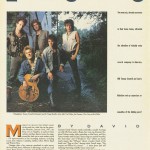
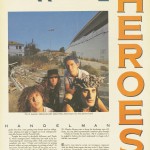
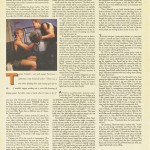
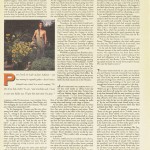
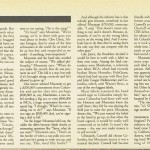
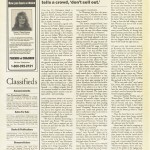
You must be logged in to post a comment.